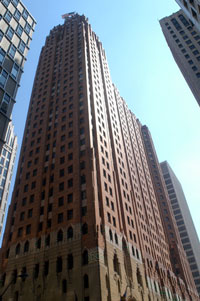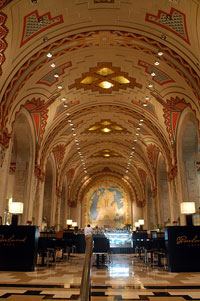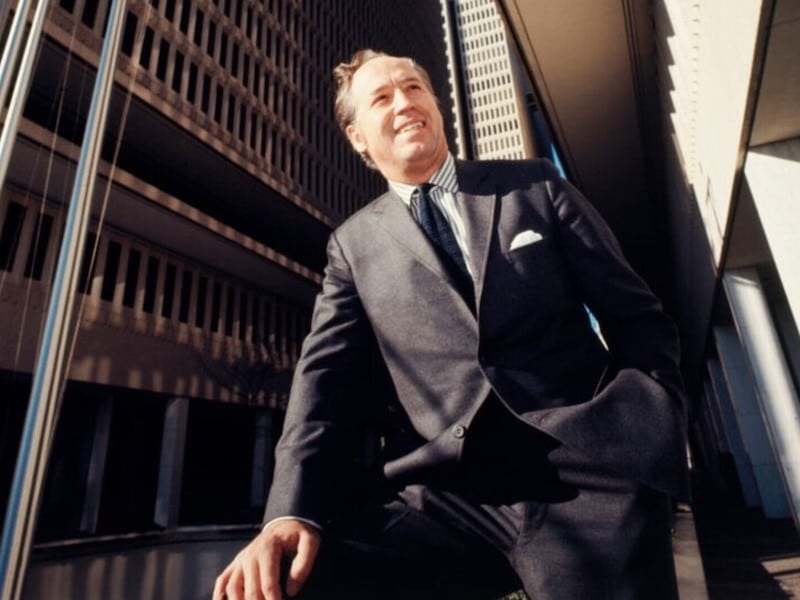Touch the Sky
The ’20s roared, and with the unbridled optimism, hubris, cash and new building technologies Detroit was blessed with three of its most compelling skyscrapers — the Penobscot, the Guardian and the Fisher buildings. Those glory days may have faded, but that’s not the end of the story.
During the roaring ’20s, Detroit’s skyline went from a low-rise 19th century town to a high-rise 20th century metropolis. Those were heady times. Money flowed. Stock market and real estate investors ran wild. Detroit had an automotive monopoly, and prohibition provided another boost to Detroit’s economy. With its Canadian border, Detroit was perfectly located to distribute bootleg spirits throughout the Midwest. Detroit was a boomtown. People came from everywhere to be in this vibrant place. Great buildings sprung from the prosperity. The roaring ’20s were also the soaring ’20s. Unbridled optimism, hubris, cash and new building technologies (i.e. the elevator and steel) united. Skyscrapers rose in big cities across America. In Detroit, the fourth largest city in the nation at the time, the most compelling skyscrapers were — and still remain the Penobscot, the Guardian and the Fisher buildings.
Before the Renaissance Center and One Detroit Center, the Penobscot, completed in 1928, was the pinnacle of Detroit’s skyline. At 47 stories plus antenna, it is still the greatest skyscraper in the city. The Penobscot was designed by Wirt Rowland of Smith, Hinchman & Grylls, one of Detroit’s oldest architectural firms, for Simon J. Murphy Jr., a lumber magnate from Maine and future mayor of Green Bay. Its stepping terraces are a true expression of the natural load path that demands thinness as it reaches toward the sky. The elaborate antenna that caps the building reminds us of Detroit’s old nickname, “The Paris of the Midwest”. Like The RCA building (now called the GE Building) in New York, the Penobscot is a powerful example of the skyscraper as civic monument. It is a mountain of a building with stepping forms like an ancient ziggurat.
The Penobscot’s 1928 sales prospectus says it all.
The Greater Penobscot Building is presented to the business men of Detroit in the hope that it will meet with their approval, not only as the newest, finest, largest and most conveniently situated of office structures but also as a befitting monument to the spirit of enterprise within themselves that has made this city great.
 If the Penobscot is a mountain, the Guardian Building is an eclectic mix — a playful and mysterious Byzantine/Gothic cathedral. Another Smith, Hinchman & Grylls masterpiece by Wirt Rowland, its ornate brick and tile create a very special richness. The vaulted interior space is like the nave of a church. The long slab exterior with vertical pilasters that accentuate its height remind us of a cathedral towering over its medieval town. The deep orange hue and brightly colored terracotta tiles are unusual for a skyscraper of any era. The color is striking and effectively contrasts the often-gray skies of Southeastern Michigan.
If the Penobscot is a mountain, the Guardian Building is an eclectic mix — a playful and mysterious Byzantine/Gothic cathedral. Another Smith, Hinchman & Grylls masterpiece by Wirt Rowland, its ornate brick and tile create a very special richness. The vaulted interior space is like the nave of a church. The long slab exterior with vertical pilasters that accentuate its height remind us of a cathedral towering over its medieval town. The deep orange hue and brightly colored terracotta tiles are unusual for a skyscraper of any era. The color is striking and effectively contrasts the often-gray skies of Southeastern Michigan.
The Union Trust Building, later named the Guardian Building, was completed in 1929. Michigan Sen. James McMillan and businessman Dexter Ferry, along with Russell Alger, Col. Frank Hecker and C.H. Buhl, founded the Union Trust Co. in 1890. It soon became the largest bank in Detroit. These were men of finance. They were focused on the bottom line but they also had vision. They knew their building could lend credibility and status to their enterprise. They spared no expense, and we are the beneficiaries of this foresight because the wonderful Guardian Building graces our skyline.
When the Fisher Building, designed by Albert Kahn, was built in 1928, critics called it the most beautiful building in the world. It is beautiful, the proportions and details are inventive and fanciful. Stone eagles adorn the entrance. Its gold gilding, green copper roof and New Center location create the most prominent and striking spire north of Downtown. Behind the graceful exterior the interior public space is a treasure. It is a grand civic space lined with shops and people milling about. The Theatre is entered from these great halls. It completes the urban experience.
Beyond its beauty, the vision of the Fisher Building and the New Center complex is remarkable for what it might have been. The existing structure was to be one bookend of a three-skyscraper composition with a 70-story central tower. The economic crash of 1929 put an end to that dream, but the seven Fisher brothers’ courage, idealism and civic concern shows through in the remaining building. The brothers came from Ohio to Detroit in 1908. Their father was a carriage maker there. In Detroit they formed the Fisher Body Co. with $50,000. They sold the company to GM for $208 million in 1928. Their fortune made, they where grateful to a city that embraced their hard work. Fred Fisher, oldest of the brothers, announced the project with civic pride in January 1927: “Our aim is to create the outstanding building in the city and express in its highest character the Fishers’ appreciation of what the city of their adoption means to them.”
These are three unique and wonderful buildings, treasures to be preserved, admired and emulated. But beyond admiration we can learn from their history.
To produce beautiful and great architecture, to support a metropolis and its infrastructure there must be a vibrant and competitive economy. In Detroit, from the beginning of the 20th century to the1960s, the auto industry, bootlegging and World War II fired the engine of capital investment. Those were exceptional times by any standard. Not many cities experience this fortunate confluence of events. We are fortunate to have had that wonderful time. But those days have waned. Times have changed and so has our economy. Many low-skill factory jobs are leaving for foreign shores. This seriously hurts a major source of the middle-class income. We search for a new prosperity. Will Detroit’s economy and built environment improve sufficiently to attract the “creative class” that Richard Florida speaks of, or will there be an industrial renaissance, some invention that reinvigorates Detroit’s industrial heritage? Whatever happens, we know that to preserve and build great buildings our local economy must improve.
A humming economy is not the only thing needed. Dedication to quality, the desire to build great buildings and superior design skill are also required. When the Penobscot, Fisher and Guardian Buildings where built, there was a visionary ethic among business leaders. They had great pride and cared deeply about quality, about making the best possible building. They understood that buildings endure as monuments to human abilities and ideals. Even though these men may have had conservative politics, they were progressive in their aspirations. They pushed the envelope.
 Detroit’s own Wirt Rowland and Albert Kahn were exceptional architects who advanced the art and craft of architecture. Fortunately, they weren’t avant-garde architects like their European Modernist colleagues. They had solid planning skills and a great sense of classical space, imagery, proportion and detailing. Their design skill, combined with an abundant and highly skilled construction workforce, resulted in buildings of exceptional quality.
Detroit’s own Wirt Rowland and Albert Kahn were exceptional architects who advanced the art and craft of architecture. Fortunately, they weren’t avant-garde architects like their European Modernist colleagues. They had solid planning skills and a great sense of classical space, imagery, proportion and detailing. Their design skill, combined with an abundant and highly skilled construction workforce, resulted in buildings of exceptional quality.
To build great buildings we need a confluence of fortunate conditions. Do we have these conditions today? Do we have enough visionary business leaders willing to spend the extra effort and money? Have the great architects in our community been discovered and allowed to pursue their art in the best way? Do we have a construction industry with sufficient craft to build great buildings? And do we have a government that encourages, values and understands great architecture? Look around at the buildings built today and ask yourself do they stand up to the Penobscot, the Fisher and the Guardian? There is your answer.
But that is not the end of the story. The world ebbs and flows. Conditions may not be perfect today, but there are some business leaders, architects, contractors and government officials in our midst who understand the value of great architecture. They want to build great buildings, and they are working to establish the right environment from which great architecture can grow. This is my hope.
Arvan is a native metro Detroiter and a graduate of Lawrence Technological University and Columbia’s Graduate School of Architecture. He’s practiced architecture in New York City and Westchester County, and taught architecture at New Jersey Institute of Technology in Newark. Arvan moved back to Michigan in 1997, and established his own firm, Royal Oak-based FX Architecture, in 2000. He is also the chair of the Royal Oak, Main Street Design Committee. Read more about Arvan at: http://www.fxarchitecture.com/
All Photographs copyright Dave Krieger





